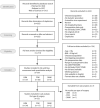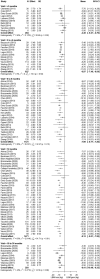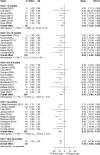The magnitude and progress of lean body mass, fat-free mass, and skeletal muscle mass loss following bariatric surgery: A systematic review and meta-analysis
- PMID: 34664391
- PMCID: PMC9285034
- DOI: 10.1111/obr.13370
The magnitude and progress of lean body mass, fat-free mass, and skeletal muscle mass loss following bariatric surgery: A systematic review and meta-analysis
Abstract
Postbariatric loss of muscle tissue could negatively affect long-term health due to its role in various bodily processes, such as metabolism and functional capacity. This meta-analysis aimed to unravel time-dependent changes in the magnitude and progress of lean body mass (LBM), fat-free mass (FFM), and skeletal muscle mass (SMM) loss following bariatric surgery. A systematic literature search was conducted in Pubmed, Embase, and Web of Science. Fifty-nine studies assessed LBM (n = 37), FFM (n = 20), or SMM (n = 3) preoperatively and ≥1 time points postsurgery. Random-effects meta-analyses were performed to determine pooled loss per outcome parameter and follow-up time point. At 12-month postsurgery, pooled LBM loss was -8.13 kg [95%CI -9.01; -7.26]. FFM loss and SMM loss were -8.23 kg [95%CI -10.74; -5.73] and -3.18 kg [95%CI -5.64; -0.71], respectively. About 55% of 12-month LBM loss occurred within 3-month postsurgery, followed by a more gradual decrease up to 12 months. Similar patterns were seen for FFM and SMM. In conclusion, >8 kg of LBM and FFM loss was observed within 1-year postsurgery. LBM, FFM, and SMM were predominantly lost within 3-month postsurgery, highlighting that interventions to mitigate such losses should be implemented perioperatively.
Keywords: bariatric surgery; fat-free mass; lean body mass; skeletal muscle mass.
© 2021 The Authors. Obesity Reviews published by John Wiley & Sons Ltd on behalf of World Obesity Federation.
Conflict of interest statement
No conflict of interest was declared.
Figures






References
-
- Sjostrom L. Review of the key results from the Swedish Obese Subjects (SOS) trial—A prospective controlled intervention study of bariatric surgery. J Intern Med. 2013;273(3):219‐234. - PubMed
-
- Wolfe RR. The underappreciated role of muscle in health and disease. Am J Clin Nutr. 2006;84(3):475‐482. - PubMed
-
- Cunningham JJ. Body composition as a determinant of energy expenditure: A synthetic review and a proposed general prediction equation. Am J Clin Nutr. 1991;54(6):963‐969. - PubMed
Publication types
MeSH terms
LinkOut - more resources
Full Text Sources
Medical

